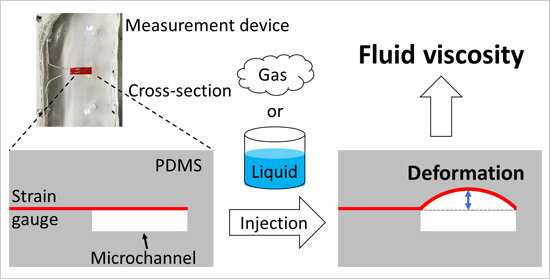Researchers develop a viscosity measurement technique for both liquids and gases

NIMS and Harvard University jointly developed a technique capable of measuring the viscosity of both liquids and gasses using the same device. This device can be used to identify unknown fluids based on their viscosities and may potentially be used to analyze biological fluids (e.g., breath and blood) for health monitoring and medical checkups. The device may also be used to investigate the physical properties and phase transitions of liquid/gas mixtures in basic research.
Liquids vary in viscosity, and we see the difference in our daily lives. For example, honey is very viscous while water is less viscous. However, viscosity is not an only characteristic unique to liquids; gasses also have viscosities. Because any fluid including both liquids and gasses has its inherent viscosity, techniques for measuring them are very important for scientific community and industry. Various types of viscometers are already available commercially and are commonly used to measure liquids, while techniques of measuring gaseous viscosity are still being researched. Accordingly, no method capable of measuring the viscosity of both liquids and gasses—two fundamentally different fluid phases—is available. Interest has been growing in recent years in connection with the development of compact and simple technologies capable of measuring and identifying both liquids and gasses, including wearable blood pressure meters and portable odor sensors. It is therefore desirable to develop a new viscosity measurement technique compatible with a broader range of fluids.
This research team recently fabricated a device made of a soft material called polydimethylsiloxane (PDMS) with an internal cavity (the microchannel in the figure) into which a fluid sample can be injected. A commercially available strain gage was embedded just above and across the microchannel. When an injected fluid passes through the microchannel, it is deformed and thus the deformation is detected by the strain gage. The team found that the extent of the deformation correlates with the viscosity of the injected fluid for both liquids and gasses. Using this correlative relationship, this simple device is able to measure the viscosity of any fluid in real time with high sensitivity.
In future research, we plan to measure the viscosity of various biological fluids (e.g., human breath and other biological gasses, saliva, urine and blood) to assess the usability of this device for analyzing and identifying them. We envision health monitoring and medical checkup applications using this device. In addition, we are considering a basic research application for this device; it could be used to measure the viscosity of fluids even during phase transition from gas to liquid and vice versa and the viscosity of liquid/gas two phases in various forms such as bubble flow, slug flow, annular flow, and so on.
More information: Kota Shiba et al, Microchannel measurements of viscosity for both gases and liquids, Lab on a Chip (2021). DOI: 10.1039/D1LC00202C
Journal information: Lab on a Chip
Provided by National Institute for Materials Science



















